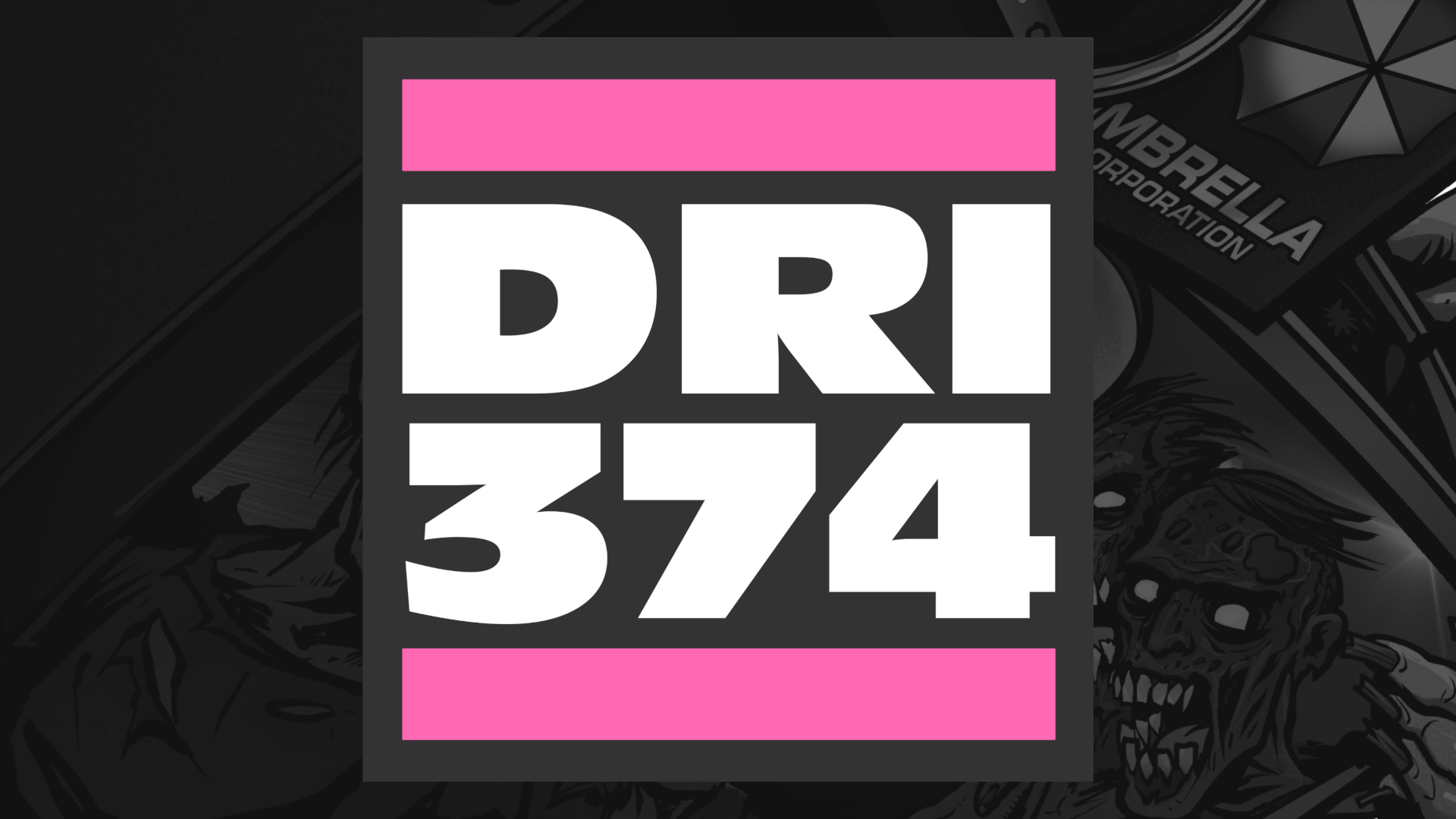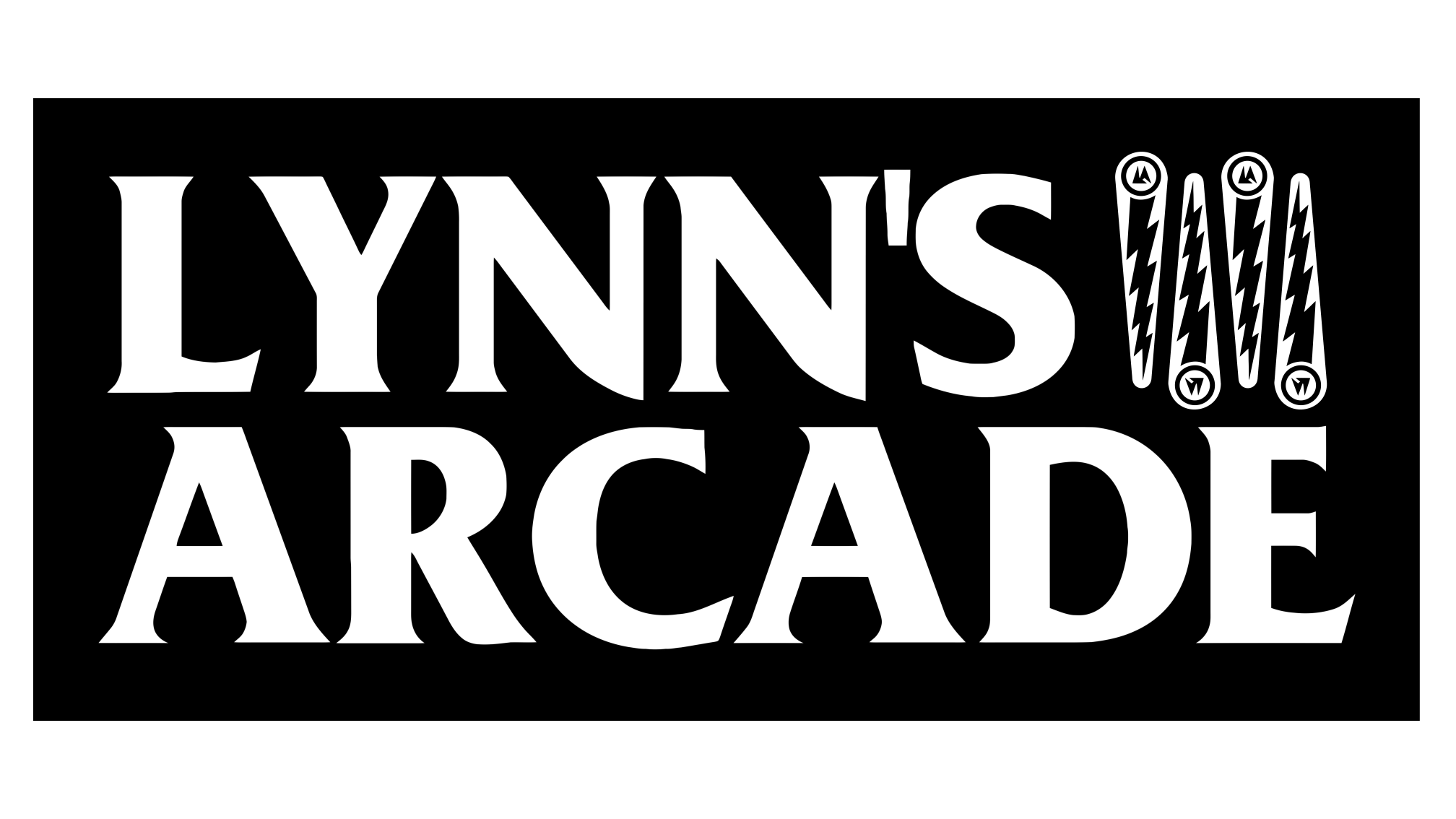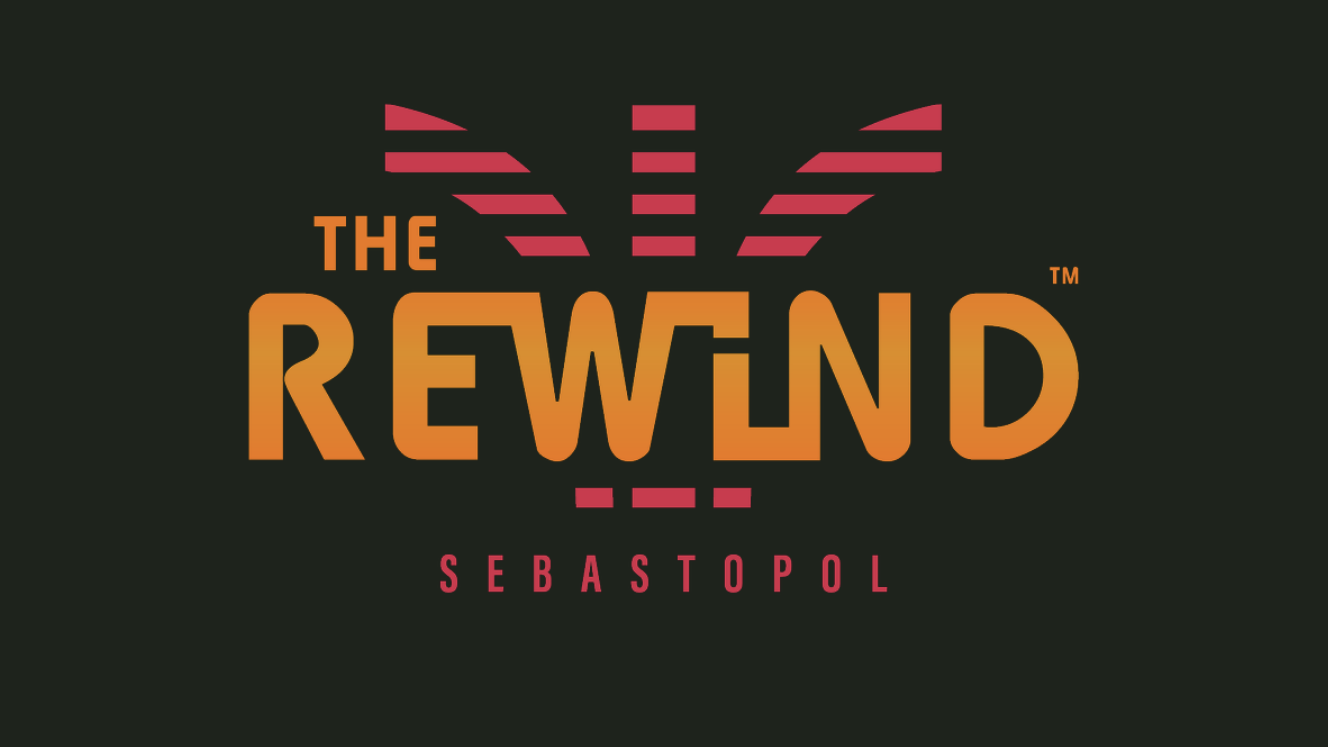This page contains the rough bill of materials for various streaming rig setups DRI374 is running and built for others.
- Raccoon City Pinball (the main studio rig)
- Raccoon City Arcade (the candy cab rig)
- The Pocket Rig (tournament and event rig)
- The Flying B-Cam (the unboxing setup)
- Miscellaneous (my favorite nick-nacks)
- Lynn’s Arcade in Seaside, CA
- The Rewind Arcade in Sebastopol, CA
Make sure to check out the Start Streaming Pinball! (slides) talk on YouTube and join us on Tilt Forums to discuss Twitch/livestream setups.
All the 8020 frames I’ve built stem from this basic frame by Karl DeAngelo. Just pay attention to if you need to roll your rig through door frames as his design does not roll under standard door frames with roller skate sized wheels. I shortened the vertical segments by 1/2”. I have a ton of add-ons I might document in the future though.
As this page is updated, the changelog lists the changes.
FYI: Most links below are Amazon affiliate links. No change in cost to you but a fraction of the margins goes to my Amazon store credit to continue this addiction.
Raccoon City Pinball
The home arcade pinball rig has evolved since early 2020 when I built a makeshift COVID rig to stream my newly acquired Stranger Things. Today, my home arcade is more of a studio than an arcade. The entire rig is one homogeneous unit only tethered by a power cord.
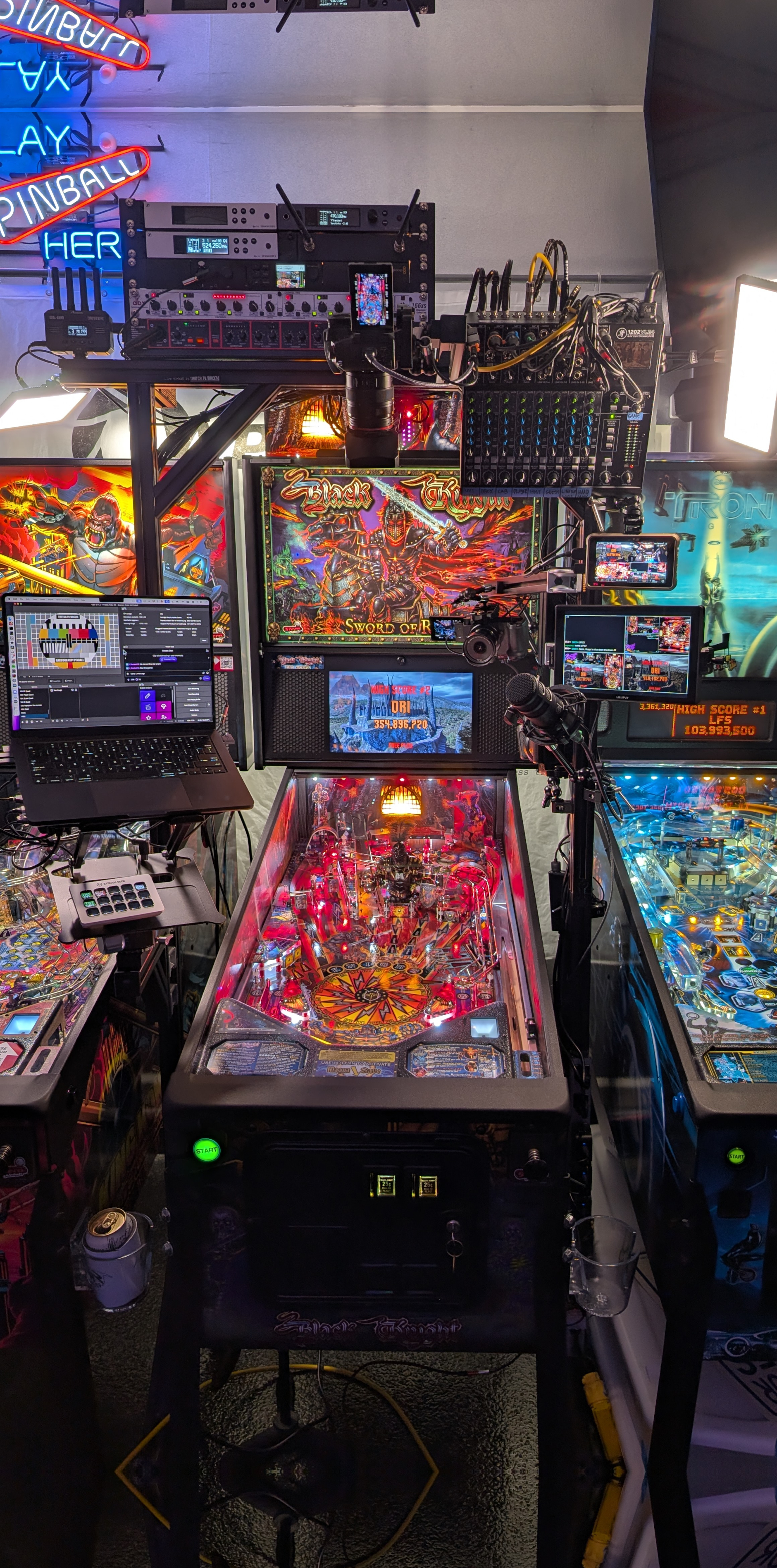
- Macbook Pro M3 Max laptop.
- Blackmagic Design UltraStudio 4K Mini capture card.
- OREI UHD-401MV 4x1 HDMI Multi-Viewer with RigC.
- StarTech Ethernet-to-Serial server1 for the Multi-Viewer (direct serial currently has issues).
- StarTech USB-C hub with Ethernet1 for more ports.
- Belkin USB-C hub for even more ports.
- Elgato Stream Deck MK.2.
- Elgato Stream Deck Pedal for fast switching.
- Lilliput A11 for chat and stream monitoring.
- Atomos Ninja 5.2” 4K HDMI recording monitor.
- 2 x VILTROX L132T (discontinued L116T sub) LED light for talent.
- 2 x VILTROX L116T LED lights for playfield.
- Audio-Technica AT2040 player mic with a Behringer VU1.
- Audio-Technica AE3000 backbox mic on a dbx 166xs (discontinued, sub dbx 266xs) channel.
- Shure PGA52-XLR cabinet mic on the other dbx 166xs (discontinued, sub dbx 266xs) channel.
- Mackie 1202VLZ4 mixer.
- LUMIX GH5M2 playfield camera with a LUMIX 10-25mm lens.
- LUMIX GH5M2 player camera with a LUMIX 9mm lens.
- LUMIX GX85 (discontinued, G85 sub) score camera with various lenses, most recently LUMIX G 25mm (works great for DMDs).
- LUMIX GH5M2 B camera with various lenses but LUMIX 12-60mm most of the time.
- Accsoon CineView HE for local program output to the studio TV.
- Mackie MP-240 IEMs.
- Sennheiser IEM G4 transmitter for IEMs.
- 2 x Sennheiser EM 100 G4 receivers for roaming talent in the studio.
The Ninja recorder uses the passthrough of the capture card and records the multi-viewer output in 2160p60 with the mixer output. Highlights destined for YouTube are rendered through a template in DaVinci Resolve for that souped up 4K rendering.
MacBooks are finicky when it comes to USB-C to HDMI adapters. Only use Apple approved hardware, like this one: Belkin USB-C to HDMI.
1 = The StarTech hub and ethernet-to-serial server is sandwiched together and used in the pocket and event transform as well.
Raccoon City Arcade
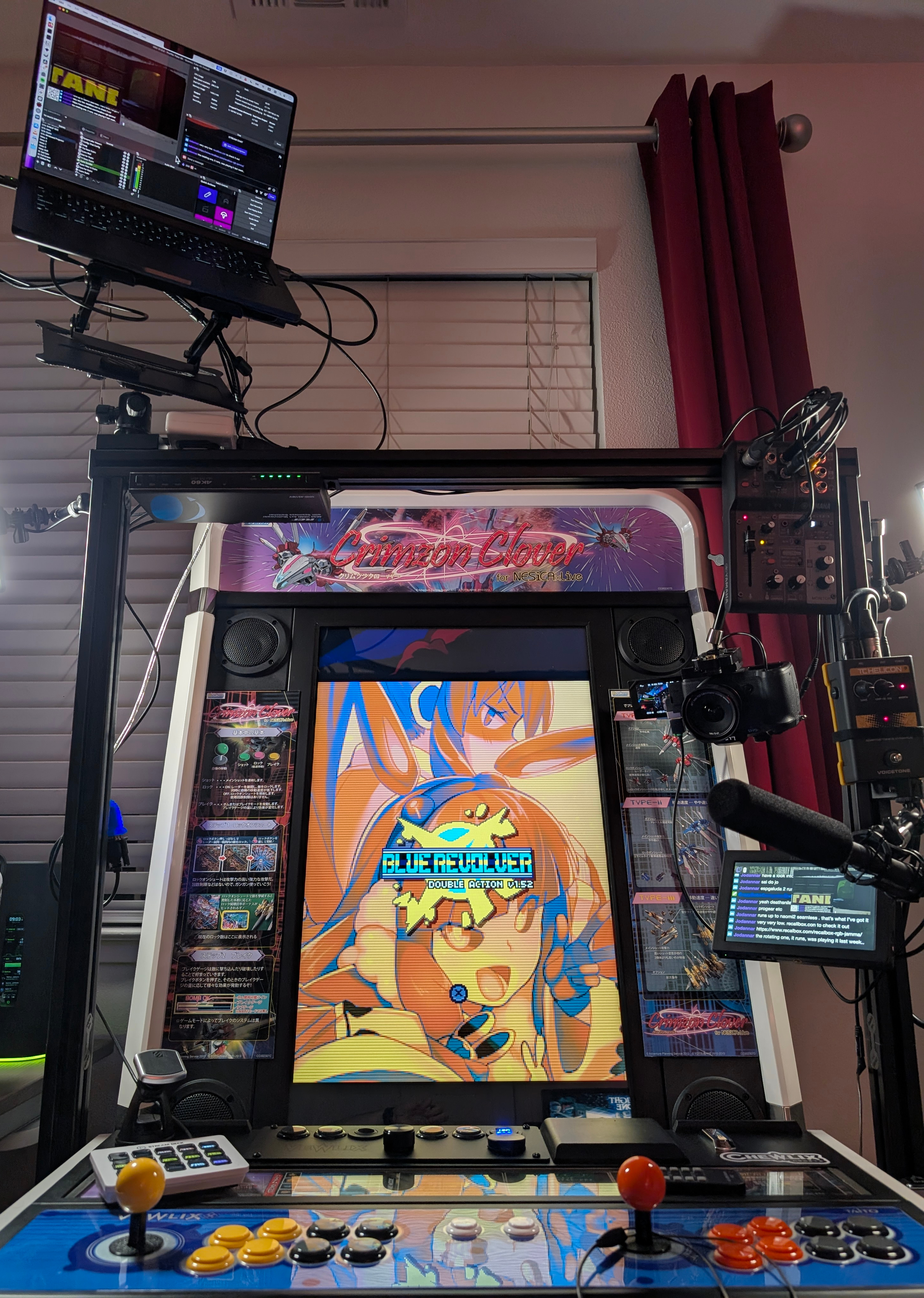
The candy cab rig is a half-height regular pinball rig. It uses the same laptop, player camera, player microphone and Stream Decks as the pinball rig.
- OREI UHD-401MV 4x1 HDMI Multi-Viewer with RigC.
- Elgato 4K X capture card.
- Yamaha AG03MK2 mixer.
- Mackie MP-240 IEMs.
- TC-Helicon VoiceTone T1 stomp box.
- 2 x VILTROX L116T LED lights.
- Lilliput A7s for chat and stream monitoring.
- NAC Splitfire + OSSC Classic for arcade game capturing.
This rig seldom see content but there’s a whole lot of ambition with several projects in the pipeline.
The Pocket Rig
The notorious “pocket rig” has seen the most evolution as I’ve always wanted to be mobile. The current incarnation has three different configurations and I’ll try describe them separately.
The Event Transform
This is the configuration that captured that notorious Metallica game at Pinball Expo ‘24. It has everything needed mounted to the rig that allow about four hours of game capture/streaming.
The only components shared with the studio rig is the laptop and the Stream Deck. The Atomos recorder might go into this build for a higher quality event capture.
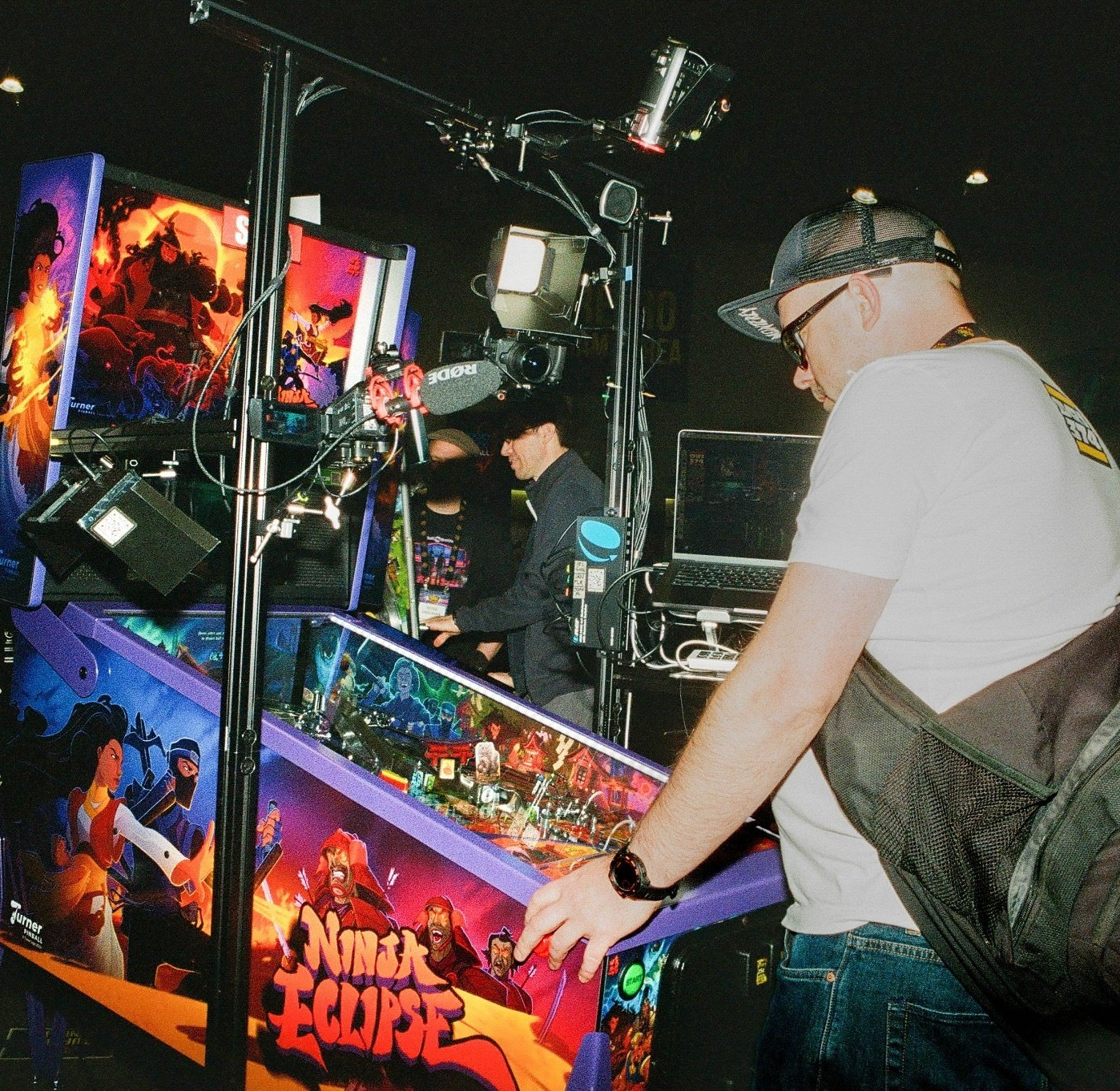
- OREI UHD-401MV 4x1 HDMI Multi-Viewer with RigC.
- AVerMedia Live Gamer Ultra 2.1 capture card.
- 3 x RØDE VideoMicro II. Player, backbox and cab.
- VILTROX L132T (discontinued L116T sub) LED light for the playfield.
- Logitech Litra Glow player light.
- LUMIX GH5S player camera with a Laowa 6mm f/2 Zero-D lens.
- LUMIX G85 with a LUMIX G 15mm lens for the playfield.
- Panasonic V785K1 score camera.
- 3 x AMEGAT/Alfox/Ravpower 140W 27600mAh power banks for all gear except laptop.
- 2 x UGREEN 145W 25000mAh for the laptop.
All the gear needed for the event rig fits into two Pelican 1510 carry-on sized cases.
1 = Both the Panasonic V785K and V770K are a bit finicky to set the correct white balance on. Put this card on the playfield glass, zoom in, and use that to program the white balance for your venue. It will be saved between power cycles.
The Single Day Tournament Transform
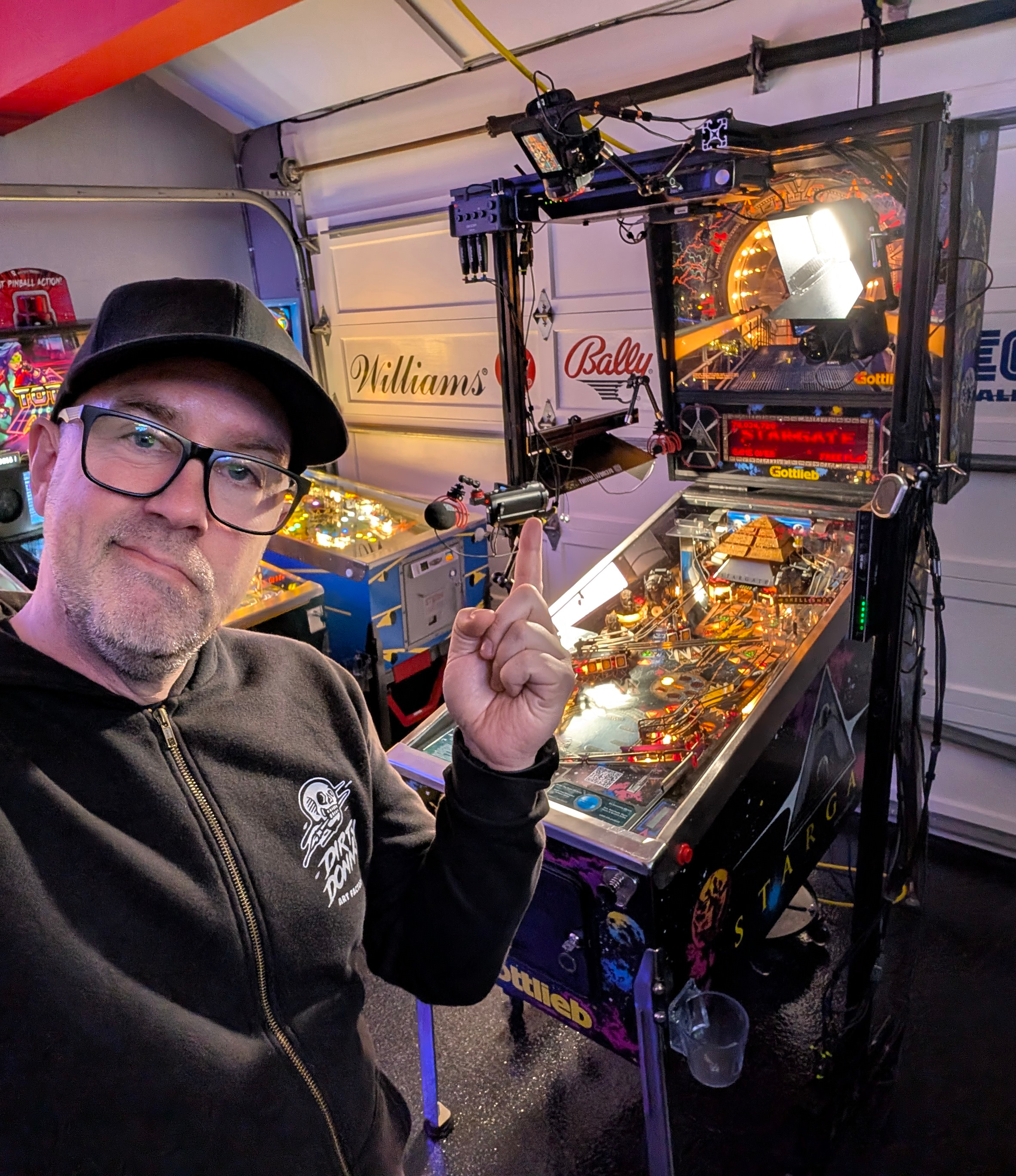
This adds another Pelican 1510 case of gear to the event transform and suitable for single day tournaments. This kit does not provide any telestrating capability and only two hosts for the broadcast. The Atomos recorder is used for tournaments to record the program as well as pushing the program to venue monitors with the passthrough to a HDMI splitter.
An additional harness is tacked onto the rig and make the mics go analog and adds an additional mic for the cabinet.
- LinkSys MR7500 mesh satellite.
- KiloView N60 NDI encoder.
- StarTech NETRS2321P (discontinued, sub) Serial-to-Ethernet for RigC.
- Maker hart Just Mic 4 mini mixer.
The broadcast station is scarce in this setup and has the following components:
- LinkSys MR7500 mesh router.
- CalDigit Thunderbolt 3 Mini Dock for more ports.
- Lilliput A7s for chat and stream monitoring.
- Blackmagic Design Monitor 3G for program recording and monitoring at the venue.
- 2 x Koss Porta Pro headsets (rarely used during one day tournaments).
- Focusrite Vocaster Two for headsets.
Technically, the single day rig can be flown with if there’s two people traveling as the gear needs to be in the cabin and the rig in the hold.
The Multi Day Tournament Transform
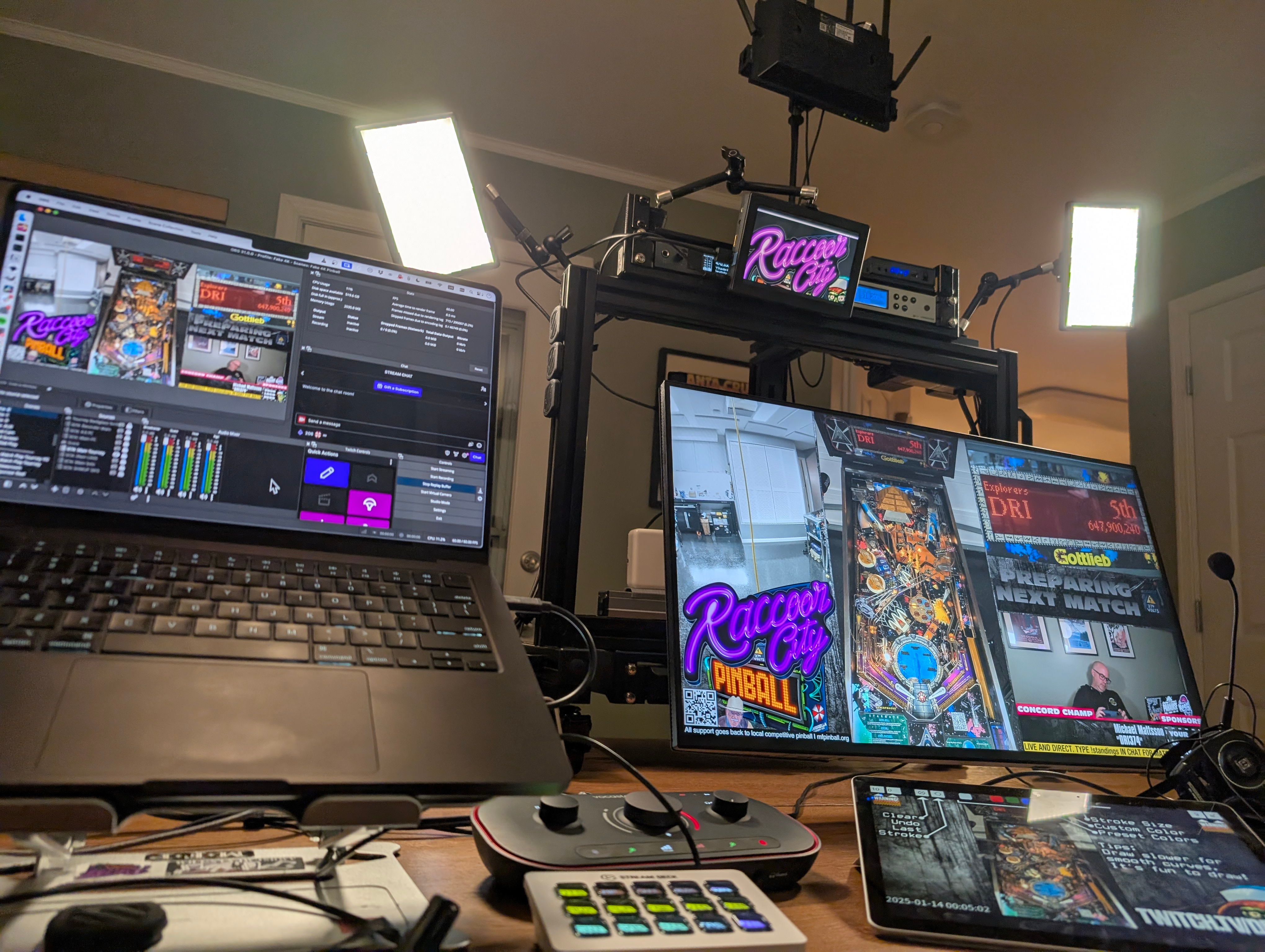
The multi day tournament transform uses all the gear from the single day transform except the 14” portable monitor.
- OREI 1x4 HDMI splitter for program outputs.
- Dell 27” FullHD monitor.
- iPad A16 with Telestripe for telestration.
- Magewell UltraEncode HDMI Plus for telestrating output over NDI.
- An additional Koss Porta Pro headset for roaming.
- Sennheiser EM 100 G4 receiver.
- Sennheiser IEM G4 transmitter.
- 2 x VILTROX L116T commentator talent lights.
- OBSBOT Tiny 2 broadcast talent camera.
The additional headset is completely wireless for both monitoring and voice and allows the broadcaster to roam freely and commentate and manage the stream from anywhere in the venue.
The Flying B-Cam
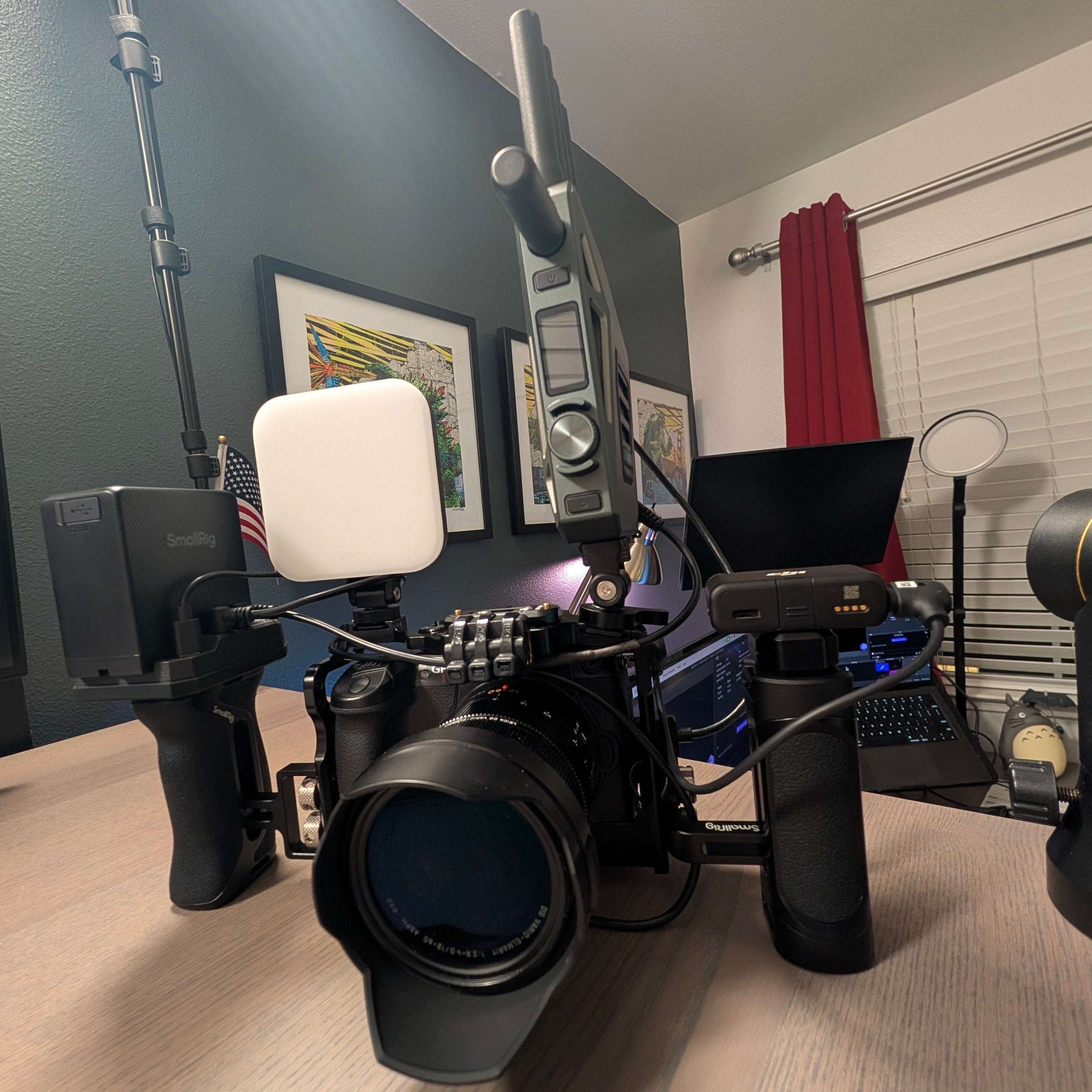
During unboxing and other tech type streams I have a “flying b-cam”, it’s not really a b-cam for all intents and purposes but it’s secondary purpose to what my productions are all about, gameplay. So, I call it a b-cam.
- LUMIX GH5M2 with a LUMIX G Vario 12-60mm lens.
- NICEYRIG cage for the house, various SmallRig handles/mounts.
- Logitech Litra Glow light.
- DJI Mic 2 wireless mics, usually with Shure MVL lavaliers.
- Accsoon CineView Master 4K for 2160p60 or 1080p60 HDMI transmission.
- Blackmagic Design UltraStudio Recorder 3G1 for unboxing streams at Lynn’s Arcade, otherwise it’s plugged into the multi-viewer.
- SmallRig NP-F970 battery powers camera, light and transmitter for about four hours.
- Manfrotto Tripod for stationary shots.
All b-cam gear fit into yet another Pelican 1510 carry-on sized case.
1 = Since the CineView Master 4K only does 12Mbit/s max I haven’t felt the need to get a 2160p60 standalone capture card for it just yet and mostly run it in 1080p60 on mobile gigs.
Miscellaneous
I’ve been through some gear over the years in terms of mounts, stands and other loose items to make life easier. This is a non-exhaustive list of favorites.
- SmallRig Magic Arms. Comes in two sizes, 9.8” and 5.5”
- CAMVATE crab clamp. Nips perfectly into the 1515 extrusions and the rubber won’t slip like with other brands.
- UGREEN USB-PD plug 160W
- Alfox USB-PD brick 200W
- Manfrotto counterfeit quick release. All my cameras have these. Although, I’ve started to flirt with the HawkLock.
- ABS plastic to DIY hoods and barn doors for lights to prevent reflections.
- The Velcro I use for for the hoods and barn doors.
- The “Velcro” rolls I use to build wire harnesses.
- A newer version of the laptop stand I use.
- Schoche magnet mounts. The laptop stand is peppered with these. Useful for small things, like USB hubs and capture cards.
- Desk and wall rack mount frame for up to 6U. Mounts perfectly onto a 1515 profile, flat or vertical.
- Flashner CamCaddie cold shoe rails. Great for mounting an Accsoon triplet on.
- Don’t want to build a 8020 frame? Get a C-stand, with wheels and a case. It holds a ton of gear.
- Monoprice makes my favorite cables. Ultra slim HDMI (good for 4K60 up to 8’) and Ethernet (10GigE up to 30’) cables.
- Monoprice also makes active HDMI (up to 15’ and 4K60) cables.
- Faracent makes excellent USB-PD extension cords (up to 10’).
- Blind Spot makes very professional USB-PD to DC barrel cables but many cheaper and more practical cables exist, work and sometimes more flexible on the output (check your power bank and device).
- When using a USB-C port to yield another HDMI port, use high quality adapters. Brands certified with Apple works best. Like this Belkin. Off brands may glitch and that glitch will cause OBS to crash (on Mac).
- Anker 4-Port USB 3.0 works for more USB-A ports and Belkin 4-Port USB-C Hub for more USB-C ports.
The power banks I buy at the moment, AMEGAT 140W 27600mAh, provide two USB-PD ports and one USB-A. These are OEMs and I don’t know the source. Ravpower had them first but then a ton of other brands started to carry them. The display with the individual draw per port is brilliant as it’s easy to balance and you get immediate feedback if there’s draw from the connected device.
Pro-Tip: The brand Anker seems to have very compelling power banks, warts, bricks and plugs. READ THE FINE PRINT: I’ve not come across a single product that does 12V 3A which is the most common voltage USB-PD is used for.
DRI374
DRI374 is an eclectic pinball and arcade streamer that stream games, tournaments and cover events from time to time. Make sure to check out the VODs and highlights on YouTube.
Lynn’s Arcade
The rig at Lynn’s I originally built for myself but the arcade decided to buy it. There’s been a few upgrades over the years and this list is the current known list of equipment.
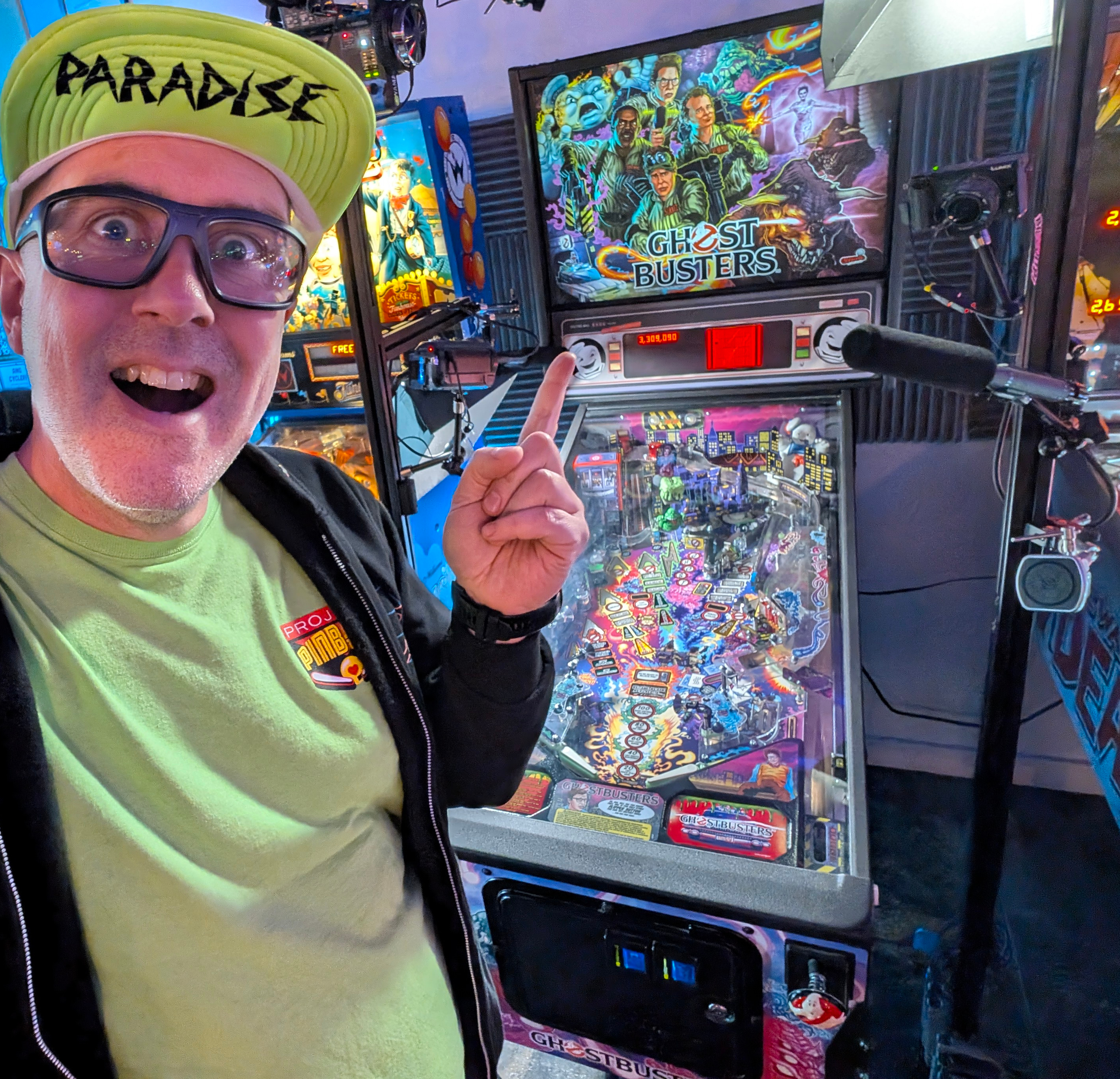
- 3 x Accsoon CineView HE transmitters
- Panasonic V770K (discontinued, sub V785K) playfield camera
- Panasonic V770K (discontinued, sub V785K) score camera
- LUMIX GX85 (discontinued, sub G85) player camera with a Rokinon fisheye lens
- 2 x Audio-Technica AT897 shotgun mics
- Yamaha MG06 mixer
- VILTROX L132T (discontinued, sub L116T) playfield light
- VILTROX L116T player light
Broadcaster station.
- HP desktop PC with a GeForce RTX 3080
- 3 x Accsoon CineView HE receivers
- Dual displays for monitoring (unknown)
- Magewell Quad HDMI capture card
- Rodecaster Duo 2 mixer
- 2 x Audio-Technica BPHS1 headsets
- LUMIX GX85 (discontinued, sub G85) talent camera with a Laowa 6mm f/2 Zero-D lens
The rig at Lynn’s Arcade can be “rented” at the arcade if you bring a laptop with a USB4 or TB3 port. Affectionately called the Rent-A-Rig (or RAR). Instructions how to use the RAR will be made available soon.
Lynn's Arcade
Lynn’s Arcade is a Pinball Parlor and Can Slangery in Seaside, CA. They stream the Monterey Flipper Pinball and Monterey Flipper Ladies Pinball leagues along with staff shenanigans and big weekend tournaments.
The Rewind Arcade
The Rewind Arcade picked up my previous generation of gear that was PC based using dedicated HDMI transmitters.
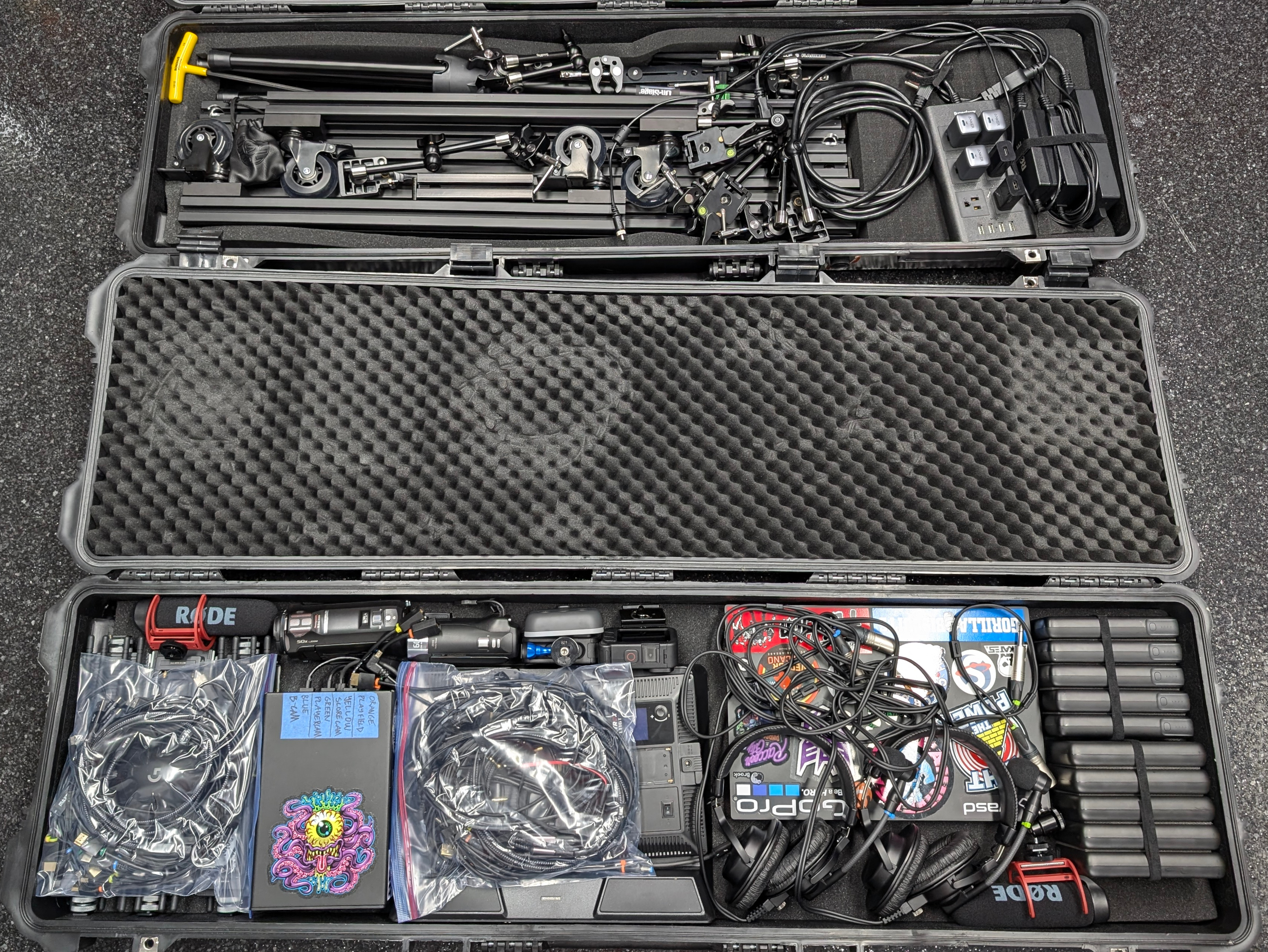
- 3 x Accsoon CineEye 2S Pro (discontinued, sub CineView HE) transmitters
- GoPro Hero 11 (discontinued, sub 13 w/ MediaMod) player camera
- Panasonic V785K score camera
- Sony CX405 (trash, sub V785K) score camera
- 2 x RØDE VideoMic GO (discontinued, sub VideoMicro II)
- 2 x VILTROX L116T LED lights
- 5 x 30,000mAh RAVPower (discontinued, sub Alfox/Ravpower/AMEGAT 140W 27600mAh or HenHot 30,000mAh) banks
The broadcast station:
- Razer Blade 15 2020
- Magewell Quad HDMI in a SonnetTech enclosure
- 3 x CineEye 2S Pro (discontinued, sub CineView HE) receivers
- Canon VIXIA HF R800 (discontinued, sub anything) broadcast talent camera
- Logitech Litra Glow player light
- Rodecaster Pro (the old model, sub with Rodecaster Duo 2)
- 2 x Audio-Technica BPHS1 headsets
Two rifle cases (Harbor Freight models) to hold all the gear.
The Rewind Arcade
The Rewind Arcade is a pinball and classic arcade game venue in Sebastopol, CA. They stream tournaments and events on Twitch.
Changelog
- 2025-10-11: New lenses on the studio rig. Added wireless mic and monitors. Swapped around cameras on the pocket rig for the next event and updated a few other items.
- 2025-07-21: Updated power bank links.
- 2025-05-22: New pocket mixer, decommissioned Zoom AMS-44, new player camera, decommissioned LUMIX G85.
- 2025-03-15: New USB hub. Clarified white balance on the V785/V770’s. B-cam rig.
- 2025-03-02: Replaced the dbx286s (gain of death) with a Behringer VU1. Clarified using RØDE mics with the Zoom AMS.
- 2025-01-29: Added some pictures.
- 2025-01-28: Cables (under Misc.) and typos and such.
- 2025-01-27: Added Miscellaneous section and dbx links. Clarified AMZN links. Link to slides.
- 2025-01-26: Initial hack.
